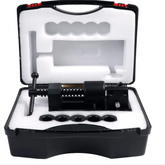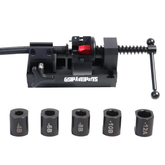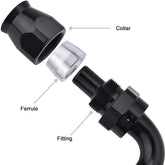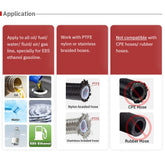Alternator fits 2010-2013 Hyundai Sonata 11-13 Kia Optima 2.4L 37300-2G150 11491
- Regular price
- $129.99
- Regular price
-
$199.99 - Sale price
- $129.99
- Unit price
- per
Couldn't load pickup availability
Description
xAbout the Product:
As the engine provides only mechanical energy, it does not generate electricity. So we need a power source which produces electricity to power all the electrical accessories in your car. And that's where the alternator comes in. The vehicle's charging system consists of a car battery, the voltage regulator, and the alternator. Your alternator converts mechanical energy to electrical energy with an alternating current. The stator and rotor inside the alternator work as magnets and rotate to generate the alternating current. Then the alternating current(AC) is transformed into a direct current(DC) that charges the battery. Both overcharging and undercharging your battery can be a serious issue. The voltage regulator sends the power from the alternator to the battery, controls the amount of energy to provide a steady flow of power to the battery.
Symptoms of Fail Alternator:
Alternators usually do not require much attention unless they are worn out. Most of them last between 7 to 10 years in optimum conditions. However, there are several ways to tell if your alternator is exhausted.
Battery needing a constant boost.If you constantly need to boost your battery, it could be the sign of your alternator needing replacement as it fails to recharge the battery.
Difficult to Start.If your car stalls, there can be various causes, but a bad alternator could be one of them. If your vehicle can't get the electricity from your alternator, it cannot run so it stalls.
Dim lights.The most common cause of dim lights from your dashboard is due to a faulty alternator.
Delaying Electrical Accessories.If your electrical accessories are moving slower, then it can be a sign that your alternator is bad.
Specification:
Type: Alternator
Voltage: 12 V
Features: Clockwise Rotation
Manufacturer Part Number: Q11875601LA
OE/OEM Part Number: AL4098X,AL4102X,37300-2G150,37300-2G400,11491
Amperage: 110 A
Performance Part: Yes
Finish: Polished Chrome
Universal Fitment: No
Vintage Part: No
Interchange Part Number: 11492,AL4102X,37300-2G150
Mileage: More Than 100,000 miles
Superseded Part Number : 11491,AL4098X,37300-2G400
Placement on Vehicle: Front
Ground Type: Negative
Fitment Type: Direct Replacement
Part Name: Alternator
Material: Aluminum
Modified Item: No
OE Spec or Performance/Custom: OE Spec
Fit for
2013 Hyundai Sonata GLS Sedan 4-Door 2.4L 2359CC l4 GAS DOHC Naturally Aspirated
2013 Hyundai Sonata GL Sedan 4-Door 2.4L 2359CC l4 GAS DOHC Naturally Aspirated
2013 Hyundai Sonata Limited Sedan 4-Door 2.4L 2359CC l4 GAS DOHC Naturally Aspirated
2013 Hyundai Sonata SE Sedan 4-Door 2.4L 2359CC l4 GAS DOHC Naturally Aspirated
2013 Kia Optima EX Luxury Sedan 4-Door 2.4L 2359CC l4 GAS DOHC Naturally Aspirated
2013 Kia Optima EX Sedan 4-Door 2.4L 2359CC l4 GAS DOHC Naturally Aspirated
2013 Kia Optima LX Sedan 4-Door 2.4L 2359CC l4 GAS DOHC Naturally Aspirated
2012 Hyundai Sonata GLS Sedan 4-Door 2.4L 2359CC l4 GAS DOHC Naturally Aspirated
2012 Hyundai Sonata GL Sedan 4-Door 2.4L 2359CC l4 GAS DOHC Naturally Aspirated
2012 Hyundai Sonata Limited Sedan 4-Door 2.4L 2359CC l4 GAS DOHC Naturally Aspirated
2012 Hyundai Sonata SE Sedan 4-Door 2.4L 2359CC l4 GAS DOHC Naturally Aspirated
2012 Kia Optima EX Sedan 4-Door 2.4L 2359CC l4 GAS DOHC Naturally Aspirated
2012 Kia Optima LX Sedan 4-Door 2.4L 2359CC l4 GAS DOHC Naturally Aspirated
2011 Hyundai Sonata GLS Sedan 4-Door 2.4L 2359CC l4 GAS DOHC Naturally Aspirated
2011 Hyundai Sonata GL Sedan 4-Door 2.4L 2359CC l4 GAS DOHC Naturally Aspirated
2011 Hyundai Sonata Limited Sedan 4-Door 2.4L 2359CC l4 GAS DOHC Naturally Aspirated
2011 Hyundai Sonata SE Sedan 4-Door 2.4L 2359CC l4 GAS DOHC Naturally Aspirated
2011 Kia Optima EX Sedan 4-Door 2.4L 2359CC l4 GAS DOHC Naturally Aspirated
2011 Kia Optima LX Sedan 4-Door 2.4L 2359CC l4 GAS DOHC Naturally Aspirated
2010 Hyundai Sonata GLS Sedan 4-Door 2.4L 2359CC l4 GAS DOHC Naturally Aspirated
2010 Hyundai Sonata GL Sedan 4-Door 2.4L 2359CC l4 GAS DOHC Naturally Aspirated
2010 Hyundai Sonata Limited Sedan 4-Door 2.4L 2359CC l4 GAS DOHC Naturally Aspirated
2010 Hyundai Sonata SE Sedan 4-Door 2.4L 2359CC l4 GAS DOHC Naturally Aspirated
Package Include
1 * Alternator
Step By Step to Replace the Alternator
1. Disconnect the battery. Find the right socket to loosen the bolt that keeps the cable on the negative terminal tight. It’s the terminal of the battery with a visible (-) sign. Once it’s loose, slide the cable off the terminal to disconnect the battery. Never work in the engine bay of a vehicle without first disconnecting the battery for safety.
2. Remove the main power cable from the alternator. The main power cable will be the thick cable attached to the alternator that runs from the battery. Depending on how much space you have in your specific vehicle, you may be able to use a ratchet, but in some, you may only be able to fit an open-ended wrench. Unscrew the bolt holding it in place and pull it from where it’s connected.
3. Release the safety clip connecting the wiring harness. The only other wiring heading into the alternator is the control harness. Use your finger or a flat head screwdriver to release the clip holding the harness together, then slide it apart.
4. Relieve tension on the belt with the auto-tensioner (if equipped). Some vehicles use the alternator itself to apply tension to the serpentine or accessory belt, but others use an auto tensioner pulley. Insert the square drive from a breaker bar into the hole in the auto-tensioner pulley and apply pressure in a clockwise direction to relieve tension on the belt.
5. Loosen the bolts on the alternator if there is no auto-tensioner. In cars without an auto-tensioner pulley, you can relieve the tension on the belt simply by loosening the two bolts that secure the alternator to the engine. These will often require a 14mm or 1⁄2 inch (1.3 cm) socket, though you may need to try others.
6. Inspect the serpentine belt for damage. Look for signs of glossing or glazing (shinier portions) on the edges and underside of the belt. Inspect both the top and underside for signs of cracking as well.If you find any of those issues, you’ll need to replace it.
7. Remove the alternator from the engine bay. With the belt pulled off of the alternator pulley and the wires disconnected, the alternator should come out freely.
8. Compare the new alternator to the old one. Before installing the new alternator, set it down on a table next to the old one you just removed. Make sure the mounting holes and wire connectors are in the same place and that the two parts are the same size.
9. Slide the new alternator into place. You might have to wiggle the alternator around to squeeze it back into place in a crowded engine bay. Be sure to hold loose wires or the serpentine belt out of the way as you get it into place.
10. Insert the mounting bolts. Slide the mounting bolts through the alternator and into the mounting bracket. Tighten them by hand until they’re snug. In cars with an auto-tensioner pulley, you can completely tighten the bolts at this point, otherwise keep the bolts loose.
11. Run the belt over the new alternator pulley. Either install the new belt or run the old belt back through all of the appropriate pulleys. If you aren’t sure how to properly route the belt, look for a diagram on the body of the car inside the engine bay to guide you. The belt will need to go around any accessories it is supposed to power in your specific vehicle.
12. Tighten the bolts and the belt. With tension on the belt applied via the alternator and pry bar, use the appropriate socket and a ratchet to tighten the two mounting bolts up the rest of the way. This will allow the alternator to keep the tension on the belt.
13. Connect the power cable and monitor harness. Reconnect the wire harness and insert the bolt that secures the main power cable to the alternator in the same order you removed them. They should install exactly as they were in the old alternator.
14.Reconnect the battery. With the new alternator in place, all you have left to do is reconnect the negative lead to the battery. Make sure you tighten it firmly so it can’t shake loose while driving.
FAQs
xHow to return and refund
We have a 30-day return policy, which means you have 30 days after receiving your item to request a return. To be eligible for a return, your item must be in the same condition that you received it, unworn or unused, with tags, and in its original packaging. You’ll also need the receipt or proof of purchase. To start a return, you can contact us at support@gstpautoparts.com. If your return is accepted, we’ll send you a return shipping label, as well as instructions on how and where to send your package. Items sent back to us without first requesting a return will not be accepted. You can always contact us for any return question at support@gstpautoparts.com.
Shipping & Delivery
xShipping & Delivery
We can ship to virtually any address in the world. Note that there are restrictions on some products, and some products cannot be shipped to international destinations.
We will process and ship out your order within 1-2 business days upon clearance of the payment. You will receive a tracking number as soon as your order has been processed. “Business days” for ship-out or delivery timeframes refer to Mondays through Fridays only. This does not include Saturdays, Sundays, and holidays that fall on a weekday when counting business days.
Gstpautoparts.com does not ship to PO Box, mailbox, HI, PR, AK, GU, and APO/FPO addresses.
Delivery Timeframe
Most orders are processed for shipment or leave our warehouse within 24-48 hours of your order confirmation date unless otherwise specified. Delivery or transit times will vary depending on the size of the package and the delivery location. Small and medium-sized packages are generally delivered within 3-5 business days (excluding weekends and holidays) from the date the packages leave our warehouse. In addition, there may be instances in which orders with multiple parts/items will have multiple tracking numbers depending on which warehouses the parts/items will be coming from. Please note that we disclaim all liability for orders that do not meet anticipated delivery dates.
When you place an order, we will estimate shipping and delivery dates for you based on the availability of your items and the shipping options you choose. Depending on the shipping provider you choose, shipping date estimates may appear on the shipping quotes page.
Please also note that the shipping rates for many items we sell are weight-based. The weight of any such item can be found on its detail page. To reflect the policies of the shipping companies we use, all weights will be rounded up to the next full pound.
Expedited Shipping
Expedited shipping is available for most small and medium-sized packages for additional charges.
Disclaimer
In order to provide all our valued customers with the most up-to-date and accurate compatibility information, GSTP is continuously implementing real-time updates to our line store. Due to the immediate nature of these updates, the correction of any errors or omissions might happen at any time without prior notice. This information may include but is not limited to pricing, availability, suggested use, fitment, compatibility, and warranties. GSTP is not responsible for any additional labor cost, charge, loss, or damage incurred as a result of correct or incorrect information, reference, or products purchased from GSTP. While we are working to avoid any errors or omissions that may appear on the GSTP website, we reserve the right to cancel any undeliverable orders based on inaccurate information.
Related Products
- Regular price
- $129.99
- Regular price
-
$199.99 - Sale price
- $129.99
- Unit price
- per
- Regular price
- $129.99
- Regular price
-
$199.99 - Sale price
- $129.99
- Unit price
- per
- Regular price
- $129.99
- Regular price
-
$199.99 - Sale price
- $129.99
- Unit price
- per
- Regular price
- $129.99
- Regular price
-
$199.99 - Sale price
- $129.99
- Unit price
- per
- Regular price
- $129.99
- Regular price
-
$199.99 - Sale price
- $129.99
- Unit price
- per
- Regular price
- $129.99
- Regular price
-
$199.99 - Sale price
- $129.99
- Unit price
- per
- Regular price
- $129.99
- Regular price
-
$199.99 - Sale price
- $129.99
- Unit price
- per
- Regular price
- $129.99
- Regular price
-
$199.99 - Sale price
- $129.99
- Unit price
- per
- Regular price
- $129.99
- Regular price
-
$199.99 - Sale price
- $129.99
- Unit price
- per
- Regular price
- $129.99
- Regular price
-
$199.99 - Sale price
- $129.99
- Unit price
- per
Recently Viewed Products
- Regular price
- $129.99
- Regular price
-
$199.99 - Sale price
- $129.99
- Unit price
- per
- Regular price
- $129.99
- Regular price
-
$199.99 - Sale price
- $129.99
- Unit price
- per
- Regular price
- $129.99
- Regular price
-
$199.99 - Sale price
- $129.99
- Unit price
- per
- Regular price
- $129.99
- Regular price
-
$199.99 - Sale price
- $129.99
- Unit price
- per
- Regular price
- $129.99
- Regular price
-
$199.99 - Sale price
- $129.99
- Unit price
- per
- Regular price
- $129.99
- Regular price
-
$199.99 - Sale price
- $129.99
- Unit price
- per
- Regular price
- $129.99
- Regular price
-
$199.99 - Sale price
- $129.99
- Unit price
- per
- Regular price
- $129.99
- Regular price
-
$199.99 - Sale price
- $129.99
- Unit price
- per
- Regular price
- $129.99
- Regular price
-
$199.99 - Sale price
- $129.99
- Unit price
- per
- Regular price
- $129.99
- Regular price
-
$199.99 - Sale price
- $129.99
- Unit price
- per
- Choosing a selection results in a full page refresh.









































